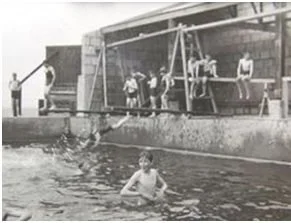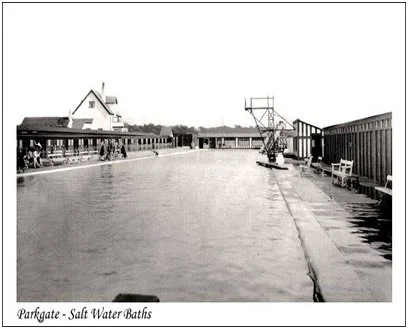The Old baths
You are standing on the site of one of the two open-air swimming pools, which during the 1920s and 1930s attracted visitors to Parkgate from far and wide in the inter-war period.
It was in 1922 that land to the north of Boathouse Lane was offered for sale, and a narrow strip adjacent to the estuary was bought by AG Grenfell, the proprietor and headmaster of Mostyn House School, an inveterate and innovative builder. Although the school already had an indoor pool, built in 1893, he saw an opportunity to provide here not only a large lido style swimming pool but also a building for stabling the school’s boats.
Development of the site began in June under the direction of Grenfell’s grounds manager, with some manual assistance by the pupils. The first pool opened in May 1923, following the construction of a private access road on a new section of sea wall leading northwards from Boathouse Lane.
An early photo of Mostyn House pupils enjoying the new facilities
It had been Grenfell’s intention that the pool should be available not only to his own pupils but that all the children in the locality should be enabled to learn to swim. So, from the outset the pool was open to members of the public as well as available for school use.
A later picture of the original pool looking north
This first pool was about 102m in length and over 15m in breadth, while its depth varied between 1.07m and 2.44m: contrary to normal practice the bath shelved from side to side rather than from end to end, the greatest depth being on the seaward side where the diving boards and water-chutes were located.
Water was extracted from the estuary at the highest tides and it went through a filtration system before admission to the pool to ensure that it was relatively clean; it was, of course, sea-water and it is said that it contained quite a population of small prawns and, no doubt, there were other creatures to be found too. In the early days, before the filters were installed, nets were used to extract any debris.
The first (100m) pool, looking south
Closely associated with the new swimming pool was the bath house (seen to the left in the picture above), built as a residence for the site manager and including a café for the benefit of customers of the baths. It was about 1924 that the James family came from Garston, Liverpool, to take charge of the business here. John James, an auxiliary postman and master window cleaner by occupation, was appointed in overall charge, while his wife Gertie looked after the café.
At the age of 16 their daughter Hilda Marjorie (1904-82), who trained at Garston baths, was already an Olympic silver medallist (1920) and later women’s world (4) or English (10) free-style record holder at almost every distance; in fact, by 1924 she is said to have held every British and European record from 100 yards to the mile.
From the age of 21 she was employed by Cunard as a celebrity swimming instructor on the company’s liner Carinthia, but she resigned in 1927 to prepare to swim the English Channel, a challenge she was not destined to attempt. During this period she was also working as swimming instructor here at Parkgate baths.
In 1930 she married Hugh McAllister, wireless officer on the Carinthia. Her story is told by her grandson Ian McAllister in ‘Lost Olympics’. In May 1995 this old bath house was destroyed in a fire; it was replaced by the present ‘Old Bath House’ in about 1999.
Hilda James, Olympic swimming medallist, daughter of the baths’ manager, & swimming instructress for Parkgate baths
The original pool was so successful that a second, smaller learner pool (shown below) was added in 1930, adjacent to and on the seaward side of the first. This shallow bath, offering ‘bathing safe for all’, actually measured about 67m by 18m); its depth varied between approx. 0.76m and 1.37m.
The small learner pool (1930) looking to the south, You can just about make out the Boat House Cafe in the distance.
An un-dated card promoting the amenities of the ‘Parkgate Salt Water Baths’ states that this facility was open every day between mid-May and the first Sunday in October, offering mixed bathing between 9.00 am and 9.00 pm, with both buffet refreshments and picnic facilities. At one end there were spacious sun-bathing areas, partially enclosed by special (anti-ultraviolet rays) glass.
Huge numbers of visitors were expected, as free parking was said to be available in the adjacent fields for up to 1,000 cars.
Also situated on this site was the Mostyn House School boathouse, understood to have been erected in 1923 to the north of the first pool, close to the entrance to Backwood Lane, for storage of the school’s small fleet of boats and sand yachts. This building is reported to have been destroyed in May 1941 by an incendiary bomb delivered by the Luftwaffe during a raid on Liverpool; it was abandoned and not subsequently restored, so there now appears to be no trace of its former existence.
In 1926 AG Grenfell was also behind the design and construction of the nearby Boat House Café, now a public house and restaurant. It is situated where an old inn, the Pengwern Arms (formerly the Ferry House), had once stood before its demolition in about 1885 following severe storm damage a few years earlier. It was from here that ferries had once plied between Parkgate and Flint or Bagillt.
Already in the late 1930s it had become obvious that war with Germany was imminent, so in February 1939 Daryl Grenfell, son of AG and current head of Mostyn House, sold the baths and the Bath House, in order to fund the construction of a substantial underground air-raid shelter at the school itself. At this time the silting of the estuary was already creating problems for the water supply to the baths, causing their temporary closure in 1942; but they re-opened after the war and continued operating with increasing difficulty until final closure became inevitable in 1950.
Following the closure, the buildings soon became derelict and the pools increasingly hazardous, so the site was acquired in 1959 by Neston Council; the pools were filled in and the area made safe; the site was later re-developed by Cheshire County Council as a picnic area and car-park for the Wirral Country Park, officially opened by Lord Leverhulme in 1973. Little now remains of the old baths other than some of the concrete walls, which have continued to protect the site from coastal erosion over the last 100 years, and the memories of the few who can still remember swimming here over 70 years ago.
Photos: David Scott collection, courtesy Burton & Neston History Society
Last Updated December 2022





